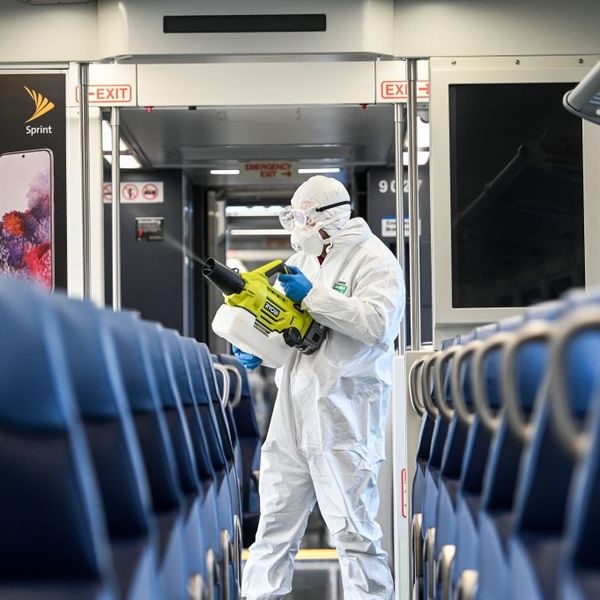OPINION — If fighting the Covid-19 virus is a war, the Army Corps of Engineers is being led into battle by an exemplary field commander, Lt. Gen. Todd T. Semonite.
The Corps’ job is to provide future hospital facilities for those cities and towns that are about to run out of existing hospital beds due to the pandemic.
If you want a clear, credible and straightforward message these days, Semonite gave it last Friday at a Pentagon press conference when he said, “Get ahead of the requirement, anticipate before you need it.”
Unlike what has marked the Trump administration’s responses up to now, Semonite said his charge is to get ahead of what additional hospital facilities are needed around the country, not today, but two to three weeks from now.
As of Friday, he said he had a list of 114 facilities that could be used and that his colonels had already assessed 81 of them as to what would be needed to make them usable. He predicted another 20 or 30 facilities would be added this week. States and localities are responsible for getting access to facilities.
The plan Semonite’s Corps has put together is simple. It calls for using four types of existing facilities — dormitories/hotels with compartmented rooms, or field houses/convention centers with large open spaces. The Corps hires contractors to modify them as quickly as possible so they can be used for either Covid-19 patients or those not suffering from the virus. The latter use would open up beds in existing hospitals for virus patients.
Someone had suggested building new hospitals in parking lots, but Semonite said, “You can’t do that in two or three weeks, and we don’t have any more time than two or three weeks so we are going into these facilities that already have electricity, they already have water, they have all the fire protection, they have all the driveways, they have all the capabilities they need.”
To modify the four types of chosen facilities, the Corps has produced standard designs that already have been approved by the Department of Health and Human Services (HHS) and the Federal Emergency and Management Agency (FEMA) as well as the White House.
Semonite even has made a plea for college and prep school faculty members who have knowledge of dormitories or other useful facilities to suggest them to local officials so a “bottom up” system of adding hospital beds could begin.
Officials from both the United Kingdom and Australia have asked to be “coached” on what the Corps is doing, Semonite said.
He emphasized the assessment element involved a team consisting of FEMA, HHS and the Corps “out talking to the city mayors, talking to the state officials to be able to say what works best for Illinois, for California…They have been in 51 governors’ offices in the last seven days.”
If governors and mayors have not requested assistance, Semonite said he told his staff “Don’t wait for the phone to ring. We’re looking at a red dot [a virus hot spot] and send a colonel out to that city, get our guy down there and go find the mayor and ask, what are you doing?”
“We’re seeing a demand signal, but we don’t know what the requirement is,” he said, adding that the Corps has “the ability to be aggressive, get ahead of the requirement, anticipate it before we need it.” He emphasized that everyone had to “work side-by-side, so it is the federal pulling hard, the state pulling hard, and the city pulling hard, everybody working together.”
As Semonite put it, “We want to be able to tailor a solution that works best for a given city or a given state.”
Have words like that, or examples of that kind of working together come out of the White House these past months?
At the time of his Friday press conference, Semonite had just returned from New York City where he had reviewed preparations for yesterday’s opening of the Javits Convention Center, which in ten days had been modified into a hospital that could take care of 3,000 non-virus patients.
“As I walked into Javits last night,” Semonite said, “there were 20 people there…the colonel from the Army hospital, and here’s the HHS team and the DHS team and everybody was around the table trying to figure out how can we stretch more beds into Javits. And this is where a lot of the challenges go away when you all have a common vision when you are trying to solve a problem all together.”
Compare that approach to Trump’s up-and-down public statements and tweets that have described his conflicts working with state governors, particularly Democrats.
Of the already assessed 81 potential new hospital bed facilities, Semonite said, “We’ve already cut contracts and we’re cutting contracts every night, to be able to get contractors to be able to come into the facilities.”
One of the largest will be at Chicago’s McCormick Place Convention Center where the plan is to have 3,000 beds for Covid-19 victims divided among three separated halls – one for 500 low acute cases, another for 1,800 higher level cases and the third for the most severe where there will be 750, isolated, self-contained units.
At his Saturday press briefing, Illinois Gov. J.B. Pritzker said, “We’re not waiting for the worst. We’re preparing ourselves for the worst.” This $75 million project, expected to be funded through FEMA, is projected to open April 24.
The Chicago Department of Public Health released a statement last Saturday that said, “The temporary health site at McCormick Place will function as a field hospital, providing a large quantity of beds, including 500 anticipated to come online in the coming week. We remain focused on working in partnership to build up resources and staffing for this site and across the system so that we can combat COVID-19, alleviate added stress to our hospitals and healthcare workers, and ensure patients across Chicago receive the care they need.”
This week, Semonite said he is scheduled to travel to Chicago where he will discuss McCormick Place and other sites, and to Seattle, Washington, where consideration is being given to creating hospital space in facilities adjoining Century Link field, home of the Seattle Seahawks football team.
Semonite also mentioned an Engineer-HHS-FEMA team is looking at a 360-bed unit in Sacramento, Calif., that may be placed in what’s called the Sleep Train Arena, the former home of the Sacramento Kings basketball team.
Meanwhile, the Corps is preparing for other possible, future sites using its normal notification process that seeks potential contractors for jobs that are not yet finalized or funded.
For example, last Friday, the Corps’ Kansas City [Mo.] District put out a notice seeking the names of potential construction firms “located in and around of the states of Kansas and Missouri” that could “support efforts” for constructing alternative virus care facilities in St, Louis, Kansas City, Columbia [Mo.], Springfield [Mo.], Topeka and Wichita.
The notice said, “Potential buildings and facilities to be retrofitted include hotels and convention centers. Hotels and convention centers may be configured as an acute alternate care facility for COVID-19 patients or a non-acute alternate care facility,” attached were draft scopes of the work to be done.
Following Semonite’s pattern to speed up the process, the notice indicated the need might be imminent, so that potential contractors were to reply by March 31, adding, “Construction firms will be required to mobilize within 1-2 calendar days of contract award, and complete work within an immediate 3-week timeline.”
Another anticipatory notice on Friday came from the Corps office in Charleston, S.C. It also called for potential contractors in that area also to respond by March 31 on their availability to convert facilities for non-acute Covid-19 patients. It adds, “Once the solicitation is released, a twenty-four (24) hour response time will likely be required.”
This notice reflected that an Engineer-led team assessment had already been made. It said if conversion of a hotel is involved, this facility “shall be supported by a nearby full-service hospital to provide logistics, materials, and waste management support and nutrition care.”
In the case of a convention center space, it will serve “ambulatory, non-critical patients,” and provide “basic healthcare functions with an emphasis on patient care, infection control, fire protection, and life safety.” It added, the converted facility “shall serve as a satellite patient ward supported by a nearby full-service hospital. The full-service hospital would provide the logistics, materials and waste management support, nutrition care etc.”
Semonite’s Corps is also preparing for possible demands even further in the future. Another notice published last Friday involved Portland, Ore. Businesses around the Portland Metropolitan Area and the Pacific Northwest were told they had until July 1, to respond as to their capabilities to “build-out or retrofit of existing space (arenas, convention centers, dormitories, hotels, or other facilities) into alternate care facilities.”
Semonite has been the Corps of Engineers commander since May 19, 2016, and his four-year appointment will be up on May 19. Although his successor, Maj. Gen. Scott A. Spellmon, was nominated by President Trump last January 17, and is awaiting confirmation, he should not be forced to step down.
When we look back to decide on heroes of this coronavirus war, Dr. Anthony Fauci will be one. Perhaps Gen. Semonite will be another.
Read more expert-driven insight, opinion and analysis in The Cipher Brief













